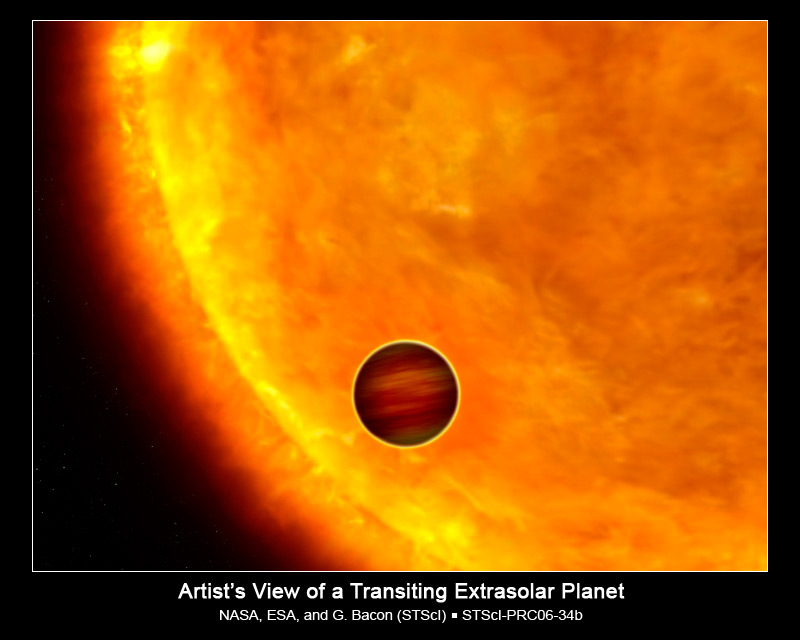외계 행성의 발견
<목성 크기의 외계 행성이 자신의 태양 전면을 통과하고 있는 'Transit' 현상의 상상도>
허블을 통해 지금까지는 관측된 바 없는 우리 은하의 중심 부분, 별들이 밀집되어 있는 부룩한 부분을 관측하여 태양계 바깥에서
일단의 행성으로 추측되는 천체들을 발견했다.
천문학자들은 우리 은하의 중앙, 불룩한 부분에 위치한 외부항성 주변에서 목성 정도 크기의 행성을 찾는 조사를 허블을 통해 수행하곤 한다.
허블을 통해 아주 좁은 영역으로 잘라낸 하늘을 관찰하여 다양한 형태의 항성(별) 주위를 공전하는 16개의 외계 행성을 포착해냈다.
천문학자들은 우리 은하에서 약 5퍼센트에 달하는 별들이 목성 크기의 행성을 품고 있을 것으로 예측하고 있다.
이것은 우리 은하에 대략 수십억에 달하는 행성들이 있을 것이라는 결과를 시사한다.
새로 발견된 다섯개의 행성 후보 천체들은 극단적인 형태의 행성들인 것으로 나타나고 있다.
'초단주기 행성(Ultra-Short-Period Planets)이라고 명명된 이들 행성들은 지구의 하루보다도 짧은 시간에 그들의 태양 주위를 공전하고 있다.
천문학자들은 행성이 그들이 속한 태양의 앞 부분을 통관하는 'Transit'이라는 현상(위 상상도와 같은 현상)이 발생할 때
별로부터 발생하는 빛이 아주 약간 희미해지는 정도를 측정함으로써 행성을 발견하고 있다.
허블 망원경은 또한 외계 태양계의 행성의 대기 구성 성분으로 처음으로 측정했는데 HD209458b라는 목성 크기 행성의
대기 구성 성분으로 나트륨, 산소, 탄수를 관측해 냈다.
허블은 또한 자신의 태양(별)에 의해 너무나 가열되어 우주공간으로 수소를 증발해내고 있는 풍부한 수소를 지닌 행성도 발견했다.
이 행성은 자신의 태양 주변을 3.5일 주기로 공전하고 있다.
이러한 일련의 독창적인 발견들은 허블과 다른 망원경들을 통해 관측된 외계 행성의 대기를 화학적으로 분석하여 얻을 수 있었다.
천문학자들은 이러한 기술을 통해 외계 태양계의 행성에 생명이 서식할 수 있는지 여부를 결정할 수 있을 것이다.
외계 행성의 대기 분석과 함께 허블은 또한 멀리 떨어진 두 개의 행성에 대한 정확한 질량 측정도 수행하였다.
* '허블사이트'의 게시물들은 허블사이트 http://hubblesite.org 의 뉴스센터 자료들을 번역한 자료들입니다
원문>
Planets, Planets Everywhere
Peering into the crowded bulge of our Milky Way Galaxy, Hubble looked farther than ever before to nab a group of planet candidates outside our solar system.
Astronomers used Hubble to conduct a census of Jupiter-sized extrasolar planets residing in the bulge of our Milky Way Galaxy. Looking at a narrow slice of sky, the telescope nabbed 16 potential alien worlds orbiting a variety of stars. Astronomers have estimated that about 5 percent of stars in the galaxy may have Jupiter-sized, star-hugging planets. So this discovery means there are probably billions of such planets in our Milky Way.
Five of the newly found planet candidates represent a new extreme type of planet. Dubbed Ultra-Short-Period Planets, these worlds whirl around their stars in less than an Earth day. Astronomers made the discoveries by measuring the slight dimming of a star as a planet passed in front of it, an event called a transit.
The telescope also made the first direct measurements of the chemical composition of an extrasolar planet's atmosphere, detecting sodium, oxygen, and carbon in the atmosphere of the Jupiter-sized planet HD209458b. Hubble also found that the planet's outer hydrogen-rich atmosphere is heated so much by its star that it is evaporating into space. The planet circles its star in a tight 3.5-day orbit.
These unique observations demonstrate that Hubble and other telescopes can sample the chemical makeup of the atmospheres of alien worlds. Astronomers could use the same technique someday to determine whether life exists on extrasolar planets.
Besides testing the atmosphere of an extrasolar planet, Hubble also made precise measurements of the masses of two distant worlds.
'3. 천문뉴스 > 허블사이트' 카테고리의 다른 글
| 허블망원경을 통해 이룩한 과학적 발견 -6- (0) | 2007.11.18 |
|---|---|
| 허블망원경을 통해 이룩한 과학적 발견 -5- (0) | 2007.11.18 |
| 허블이 관측한 홈즈 혜성 (0) | 2007.11.17 |
| 허블망원경을 통해 이룩한 과학적 발견 -3- (0) | 2007.11.15 |
| 허블망원경을 통해 이룩한 과학적 발견 -2- (0) | 2007.11.14 |
